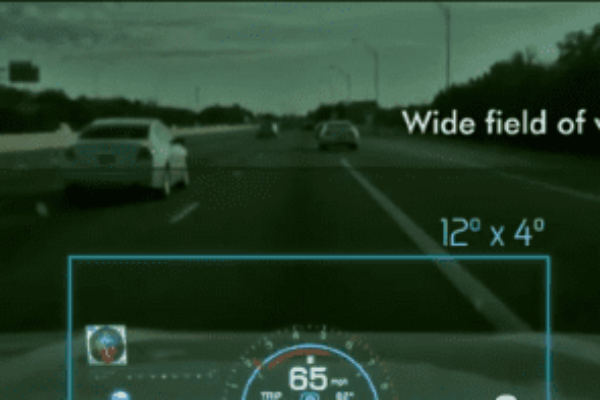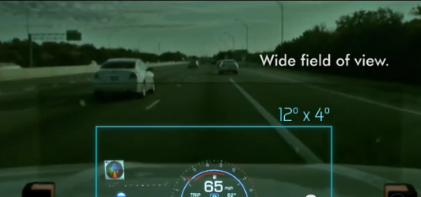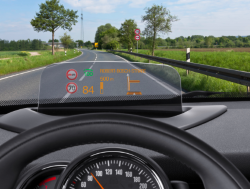
Cars today already come with many screens, including a big center-stack display and an instrument cluster. But, all those displays, with all their navigation aids and safety alerts, pose the problem of driver distraction.
Texas Instruments is one of the companies banking on head-up display (HUD) as the solution, calling it “the ADAS display of the future.”
TI’s argument is that HUD allows the driver to keep his eyes on the road while reading alerts and warnings that appear on the windshield.
Jeff Dickhart, product line manager of TI’s DLP automotive business, told EE Times, “We think DLP-based technology can create a completely new kind of head-up display that takes advantage of a wider field of view and a larger display area.”
TI is rolling out the company’s first automotive qualified DLP chipset for HUD application. One key advantage is that the chipset enables HUDs with “the industry’s widest field of view (FOV) up to 12 degrees,” claimed Dickhart.
This compares to the 4- to 6-degree FOV prevalent in currently available HUDs, according to Mark Boyadjis, senior analyst & manager, Infotainment & HMI, IHS Automotive. “Twelve-degree FOV looks noticeably larger” on a windshield, he said. “We expect TI to move into the high-end HUD market — which the next-generation Audi or BMW, for example, are going after.”
Rapidly growing HUD market
IHS is bullish on HUD’s growth. Boyadijis said the global market, which was only 500,000 units five years ago, is expected to expand to 2.5 million units by the end of this year. The market research firm forecasts 11 million units by 2020 and 2021. “If not in every vehicle in every country, it is growing very rapidly,” the IHS analyst said.
So, what are the fundamental differences in today’s HUD and the DLP-based HUD being promoted by TI?
Asked about the current HUDs, Mark Fitzgerald, associate director of automotive practice at Strategy Analytics, explained that the leading solutions are light-source displays with a series of mirrors, such as Continental’s HUD, and combiner HUDs like those used by Bosch.
In light-source display, mirrors direct light to the base of the windshield and a filter reflects the image. The image appears on the windshield in the driver’s line of sight.
Combiner HUDs are typically small, translucent screens located in front of the driver. These devices, which combine a projector and a display, use a small flip-up screen on the dashboard.
In contrast, TI is leveraging its own Digital Light Processing (DLP) technology, used in digital cinema, for its automotive HUD.
Deployed at the heart of DLP is a Digital Micromirror Device (DMD), an electrical input, optical output micro-electrical-mechanical system (MEMS) device. Each DMD contains up to 2 million individually controlled micromirrors, with each micromirror representing a pixel.
TI’s Dickhart noted that DLP functions independent of light sources. It can use either an LED or a laser diode as its source, for example. DLP not only offers better brightness, contrast and image quality compared with conventional HUD, but also provides a wider field of view, he claimed. A larger display area enabled by the DLP-based HUD’s wider FOV DLP opens new opportunities for car OEMs to add augmented reality ADAS information on HUD, Dickhart added.
However, bringing in a whole new technology to the automotive market is always a challenge. Strategy Analytics’ Fitzgerald pointed out that DLP is “unknown in the market.” Pricing is another issue.
Dickhart, however, made it clear that DLP is a well understood technology, already deployed by commercial customers in digital cinemas and personal electronics. TI has the prowess to manufacture the DLP chipset in volume. More important, automotive-qualified DLP chips will offer car manufacturers “consistent operation over extended temperatures and lifetime,” he explained.
TI has been cagey about the cost of DLP chipsets. Both analysts from IHS and Strategy Analytics said they aren’t sure how much DLP-based HUD will cost compared with other technologies. Dickhart explained that TI is enabling not just a new HUD "but a completely new kind of HUD.”
IHS’ Boyadijis speculated that DLP will move into the high-end HUD market segment, while currently available technologies — projected HUD and combiners — are steadily moving down-market.
He attributed the growth of the HUD market to three factors. “The cost is coming down, the size of the HUD package is getting smaller, and the value of its output is going up.” What used to be only a black-and-white rendition of images is already turning full-color and image quality is getting much higher, Boyadijis observed.
In fact, DLP isn’t alone when it comes to the new technologies emerging on the HUD market. One example is a full-color laser holographic HUD, now used in the Jaguar Land Rover, Boyadijis pointed out. That technology was developed by Two Trees Photonics, formed in 2010 with backing from ALPS Electric Ltd, a major Japanese electronics manufacturer.
Why wider FOV?
The wider FOV proposed by TI’s DLP technology is adding a new dimension to the future of HUD. Dickhart said that unlike conventional HUD which floats a virtual image from 1.2 meters to 2 meters away from a driver’s vision, the wider FOV HUD can float a virtual image with a depth perception of 7, 10 or even 20 meters ahead.
“The farther out you can project an image, it will look more natural to your eyes,” he said, “since it minimizes the time it takes for your eyes to refocus.”
This opens the door for Tier Ones and OEMs to add and paint navigational arrows or real-time landmark details — displayed as augmented-reality elements onto HUD, Dickhart explained.
IHS’ Boyadijis agreed. “Now, [automotive] designers are starting to see the opportunity as to what can be done with HUD.”
While Boyadijis doesn’t believe HUD will be an end-all, be-all cockpit display for ADAS, he said, “Carmakers have begun talking about a new scenario, in which the role of a center stack display and that of a HUD could be flipped.”
TI’s new automotive qualified DLP chipset, dubbed DLP3000-Q1, consists of a DLP 0.3-inch wide video graphics array (WVGA) DMD and DLPC120 controller.
The chipset is sampling now with automotive manufacturers and tier-one suppliers. The DLP 0.3-inch WVGA DMD will be offered in a Type A package and the DLPC120 will be available in a ZXS package, according to TI.
— Junko Yoshida, Chief International Correspondent, EE Times
Related articles:
Nvidia computer as processing hub for self-driving cars
Xilinx flexes its muscles in the ADAS arena
Vehicle-in-the-Loop speeds automotive design cycles
 If you enjoyed this article, you will like the following ones: don't miss them by subscribing to :
eeNews on Google News
If you enjoyed this article, you will like the following ones: don't miss them by subscribing to :
eeNews on Google News






